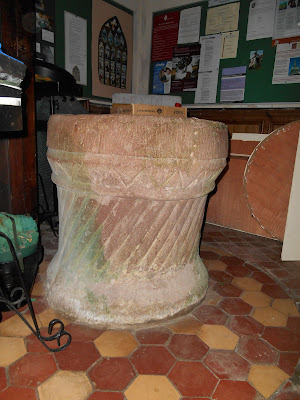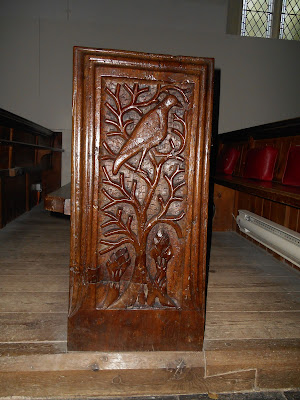The priory church was enlarged c1180 when the apses were demolished and a choir and two side aisles were built. The Priory of Stoke Courcy was considered to be an alien house, as it was staffed by a prior and monks from the mother house in Normandy and its profits were sent there. It was never a large or rich priory.
After war broke out between England and France in 1295, alien priories were taken over by the Crown, but the monks were allowed to continue living there. They were sequestered and dissolved by Henry V in 1414. The revenues of the estates of Stoke Courcy Priory were used by Henry VI in 1440 to endow Eton College. The Priory church became the parish church. The rest of the priory was demolished. In 1921 Eton College sold off most of the Stoke Courcy estates but they kept the Priory Farm, the tithes and the patronage of the church.
The church was restored and altered in the 15th century and the south aisle became the chapel for the Verney family. In around 1500 the nave and the choir aisles were rebuilt and a north porch was added. The Fairfield chapel was built in the angle between the nave and the south transept.
The nave was extensively rebuilt and the roof was replaced in 1824 by an architect called Richard Carver. The sanctuary and chancel were rebuilt 1863-65 by the architect John Norton. The Fairfield chapel was demolished at this time.
The floor of the church was excavated 1939-40 by the Reverend Basil Tucker, who was vicar from 1925-53. He was looking for the remains of the medieval church. He changed the layout of the church and the levels of some of the floors. He also set a fossil of an ichthyosaurus in a piece of blue lias stone into the floor of the north transept. It was probably discovered in the Street area and was moved into the church from the burnt-out ruins of Corner House in Shurton.
The church contains two Norman fonts, one of which came from St Andrew's Church in Lilstock. The other font has four heads carved around the top.
There are a number of 16th century carved wooden bench ends, one of which depicts a spoonbill with an eel in its mouth: this is thought to be an image unique to Stogursey. The bench ends were probably carved by a man called Glosse c1524-9
A very ornate chandelier was given to the church by John Bayley of Bridgwater in 1732. It was restored in 1906 and again in 1963.
The church's Elizabethan wooden pulpit was sold c1863 and replaced by a stone pulpit. The original pulpit is now at West Huntspill Church. The stone pulpit was replaced by the present one, which was built by Reverend Tucker in the 1940s from a Jacobean reading desk, which came from an unknown church in Essex.
The wooden funeral bier was presented to the church by the Rev Clement Malet when he retired in 1919.
The east capital of the north transept arch has a creature carved on it, which has the body of a horse but the head of a lion.
The Verney Chapel contains tombs of the Verney family and their descendants, the Palmers, Wroths and Aclands. These people all lived at Fairfield, which is a manor house a mile to the west of Stogursey.
Low down on the south eastern pier of the crossing there is a sanctuary ring. In the Middle Ages people accused of crimes could seek sanctuary in a church or cathedral if they touched the ring. They could then swear an oath agreeing to stand trial or confess to the crime and to leave the country and never return. After 40 days if they still hadn't agreed to confess or stand trial, they couldn't be removed from the church, but they could be starved into submission. If they agreed to leave the country but arrived at the port and there was no ship ready to set sail, they had to wade into the sea up to their knees or neck to show their inability to leave. Sanctuary was abolished by an Act of Parliament in 1623.
Due to various alterations and the 1940 excavations different parts of the church are on different levels. The floor of the crossing slopes, there are steps up in the chancel and more steps up to the sanctuary.
Further reading:
The Priory Church of St Andrew, Stogursey by Richard Ballard. Published by Stogursey PCC, 1992
Funeral bier
Chandelier
Sanctuary Ring
Pulpit
Stogursey's Norman font
Font from Lilstock Church
Capital with the horse/lion carving
Tomb of John de Verney, who died in 1447
The tomb of William de Verney, 1333
He is depicted holding his heart
Elaborate memorial in the Verney Chapel
Another elaborate memorial in the Verney Chapel
Bench end with a dragon on it?
Not sure what this chap in a loin cloth is doing
Spoonbill with an eel in its beak on a bench end
Bird in a tree bench end





















No comments:
Post a Comment